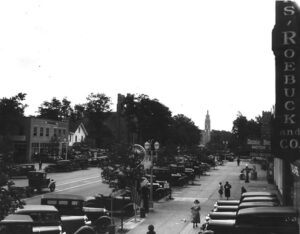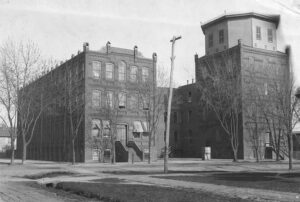
Vineland's History
Broad streets carved through a dense wilderness.
 Like other ambitious entrepreneurs of the nineteenth century, Charles K. Landis saw promise in the wilds in South Jersey. With a partner, Landis was involved in the establishment of Hammonton in the late 1850s. Soon thereafter, the 28-year-old Philadelphia attorney then decided to create his own utopian community. In 1861, he purchased about 20,000 acres of scrubland at the heart of Cumberland County from Richard Wood of Millville. Landis literally carved broad streets through a dense wilderness, allowing him to create what would later become both the town and surrounding borough that he christened “Vineland.” Landis wanted his community to be a place that incorporated both high moral standards with growing industry. As a result, Vineland welcomed many different religious denominations, and encouraged the development of business.
Like other ambitious entrepreneurs of the nineteenth century, Charles K. Landis saw promise in the wilds in South Jersey. With a partner, Landis was involved in the establishment of Hammonton in the late 1850s. Soon thereafter, the 28-year-old Philadelphia attorney then decided to create his own utopian community. In 1861, he purchased about 20,000 acres of scrubland at the heart of Cumberland County from Richard Wood of Millville. Landis literally carved broad streets through a dense wilderness, allowing him to create what would later become both the town and surrounding borough that he christened “Vineland.” Landis wanted his community to be a place that incorporated both high moral standards with growing industry. As a result, Vineland welcomed many different religious denominations, and encouraged the development of business.
Landis heavily promoted his new town in newspapers and magazines throughout the United States. Before long, Vineland was known as a mecca for both intellectual and industrial growth. He required that all prospective buyers build a home, live on their land, and plant fruit trees within the first year of purchase to prevent land speculators from interfering with his plans for the town. He also built and offered for sale “turn-key” farms, with a dwelling and the lands planted with various fruit trees and other fruit-bearing plants. For example, in 1869, his offerings included a 20 x 24-foot house with five finished rooms on two lots planted with apple, pear and cherry trees for $1,900.
 When the Civil War erupted, Vineland’s population was so small that Landis didn’t want to lose any of the men to the military. As a result, he and a number of other Vineland citizens paid a bounty that would allow the government to send someone else in each man’s place. Ever the entrepreneur, Landis promoted the city to veterans of the war, especially to those from New England, by emphasizing Vineland’s more temperate climate and the superior quality of its soils for farming. As a result, by the end of the war and the several years following, so many veterans had moved to Vineland that the population jumped from a few hundred residents to more than 5,000.
When the Civil War erupted, Vineland’s population was so small that Landis didn’t want to lose any of the men to the military. As a result, he and a number of other Vineland citizens paid a bounty that would allow the government to send someone else in each man’s place. Ever the entrepreneur, Landis promoted the city to veterans of the war, especially to those from New England, by emphasizing Vineland’s more temperate climate and the superior quality of its soils for farming. As a result, by the end of the war and the several years following, so many veterans had moved to Vineland that the population jumped from a few hundred residents to more than 5,000.
The development of railroads in New Jersey contributed greatly to Vineland’s growth. The first tracks were laid in 1865 along the Boulevard. In the years that followed, produce, livestock and manufactured goods were shipped to cities throughout the northeastern United States. When they weren’t at work, local residents enjoyed gathering at places like Cosmopolitan Hall on Plum Street or the Grand Theater on Landis Avenue to enjoy everything from thought-provoking lectures to popular plays. Nationally-known speakers such as Frederick Douglas, Susan B. Anthony and Elizabeth Cady Stanton came to this cultural mecca to lecture on topics such as abolition and women’s rights.
Although Vineland, like most of America, was hit hard by the Great Depression, it rebounded after World War II. The town became known as the “Egg Capital of the World,” as chicken farming grew as a local industry. In 1957, the town and surrounding borough incorporated into one 69-square-mile community, making Vineland the largest town (by area) in New Jersey.
History and photos courtesy of Vineland Historical and Antiquarian Society

